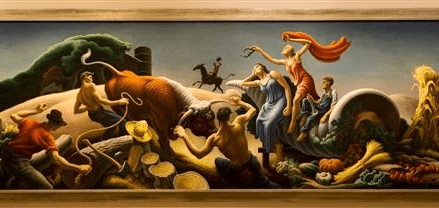Title of Artwork: “Achelous and Hercules”

Artwork by Thomas Hart Benton
Year Created 1947
Summary of Achelous and Hercules
Artwork for a mural entitled Achelous and Hercules (1947) was commissioned in 1946 by the Harzfeld department store in Kansas City. Benton drew inspiration for the mural from a narrative about Achelous and Hercules in Bulfinch’s Mythology, a collection of myths and legends from different times in ancient Greece.
All About Achelous and Hercules
The origins of agriculture are explained by this myth: It is said that during floods the river god Achelous appears as a furious bull and travels throughout the land, carving new channels in the ground with his horns.
It is said that Hercules was beaten by Achelous after cutting off one of his horns, which subsequently turned into nature’s cornucopia, a classical antiquity emblem of richness and nutrient abundance. When rivers flood and ruin crops, the myth explains how agriculture’s development is tied to river control.
Benton reinterpreted the Greek epic in the context of the American Midwest in his mural. Hercules is shown as a cowboy from the Midwest, and the fruits and vegetables spilling from the cornucopia are local produce. The rural communities of the Midwest are well-represented in the artwork.
The allegorical figure of Victory sits on the cornucopia, presenting a laurel lead and a fluttering red drape, to separate this from a conventional midwestern farm scene. As he told the tale of Achelous and Hercules, Benton touched on local and national themes alike.
The myth was pertinent to Benton’s environment and the Army Corps of Engineers’ efforts to regulate the Missouri River. “The story is therefore pertinent to our own land,” the artist wrote.
In our Missouri River, a Hercules-sized effort is required. The mural depicts the richness and wealth of the Midwest and American agriculture. Because of the Marshall Plan, President Truman’s endeavour to help reconstruct Western Europe’s economy following World War II, this topic was current.
The myth was reimagined by Benton in a way that represented current American living. The artwork served as a metaphor for the artist’s current career state. The mural was created by Benton during a period when he was considered a loud, gawky, and provincial artist by the East Coast art community.
In the mural, Benton responds to his detractors by promoting his figurative style and stressing the vivid colours and vivacity of his athletic characters. In the 1940s, Achelous and Hercules is a stark contrast to the art that was emerging in New York City.
The decade was dominated by Abstract Expressionism, a style popularised by artists including Mark Rothko, Adolph Gottlieb, and Benton’s former student Jackson Pollock. Benton’s painting not only celebrates the riches of Midwestern agriculture but also the richness of Midwestern art.
Harzfeld’s department store in Kansas City hanged Achelous and Hercules in 1947. The Smithsonian American Art Museum acquired it in 1985 and presently displays it on the second floor of the North Wing of the Museum.
Information Citations
En.wikipedia.org, https://en.wikipedia.org/.
Recommend0 recommendationsPublished in Artworks





Responses